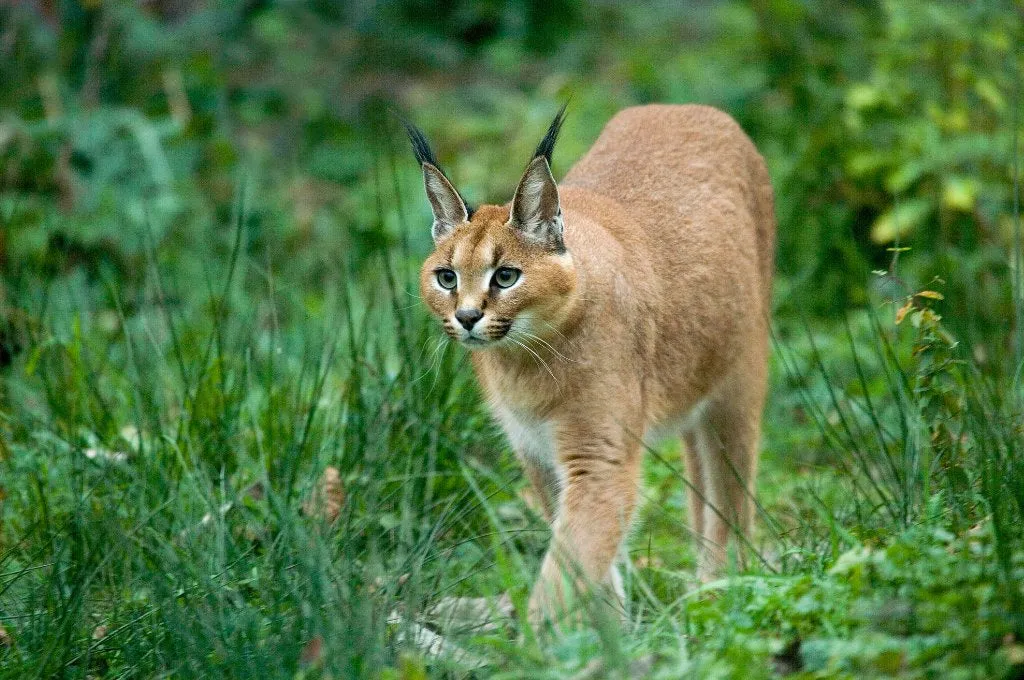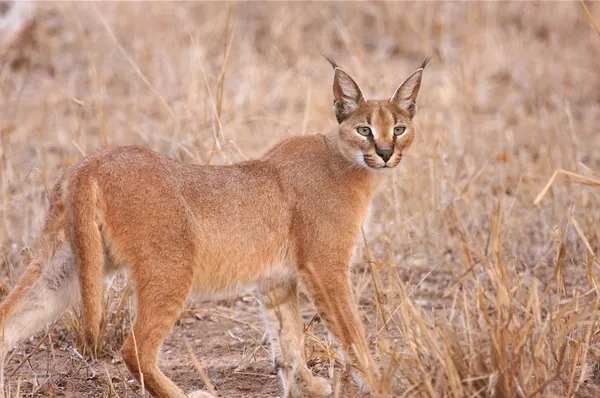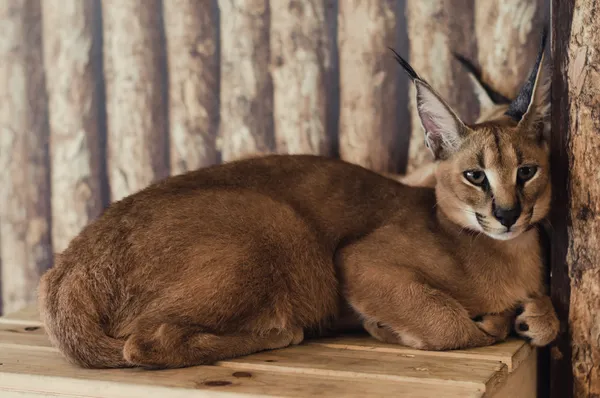I. Introduction: The Enigmatic “Floppa Cat”
The digital world has introduced us to countless captivating phenomena, and among them, the “Floppa cat” stands out as a unique feline celebrity. This internet sensation, often seen gracing social media feeds with its distinctive appearance, has sparked curiosity among cat enthusiasts worldwide. While many refer to it as the “Floppa Breed,” it’s crucial to understand that “Floppa” is not a recognized domestic cat breed by major registries like The International Cat Association (TICA) or the Cat Fanciers’ Association (CFA). Instead, the term “Floppa” has become synonymous with the majestic Caracal, a wild cat species renowned for its striking features.
This article delves into the fascinating world of the “Floppa cat,” exploring its origins as an internet meme, its close association with the wild Caracal, and the responsible considerations for those captivated by its allure. We’ll unravel the true characteristics of the Caracal, address the realities of their ownership, and separate fact from viral fiction, ensuring our readers have accurate and helpful information about this extraordinary feline.
II. What is a “Floppa Cat”? Tracing the Meme to the Caracal
The name “Floppa” itself is believed to derive from “floppy” or “floppiness,” perhaps humorously referring to a relaxed or quirky demeanor captured in viral images and videos. However, the cat that truly embodies the “Big Floppa” meme is the Caracal. This medium-sized wild cat, native to Africa, the Middle East, Central Asia, and India, gained internet fame through various viral posts, with one particular Caracal named Gosha often credited for popularizing the image. The meme typically highlights the Caracal’s impressive ear tufts and imposing yet sometimes comically expressive facial features. This cultural phenomenon has transformed a powerful wild predator into an adorable, albeit often misunderstood, online icon.
III. The Caracal: A Closer Look at the Wild Inspiration
The Caracal (Caracal caracal) is a formidable wild cat species, renowned for its athletic build and distinctive features. These cats thrive in diverse habitats, including savannas, woodlands, and scrub forests. Unlike the misleading “floppy” description sometimes associated with the “Floppa” moniker, Caracals are characterized by their tall, erect ears crowned with prominent black tufts. These tufts, which can be up to 1.75 inches long, are not merely decorative; they are thought to aid in hearing, helping the Caracal locate prey with incredible precision.
Physically, Caracals are medium to large-sized cats, with males generally larger than females, typically weighing between 10 to 20 pounds. They possess a short, dense coat, usually a uniform tawny-brown, brick-red, or sandy color, with distinctive black markings around their eyes and on the back of their ears. Their powerful hind legs allow them to jump astonishingly high, an adaptation for catching birds mid-flight.
 A Caracal cat with its distinctive long, tufted ears and alert gaze, embodying the 'Floppa' image
A Caracal cat with its distinctive long, tufted ears and alert gaze, embodying the 'Floppa' image
IV. Distinctive Characteristics and Temperament
The allure of the “Floppa” image often evokes a sense of friendliness and docility. While the internet meme can make Caracals appear charmingly placid, it is vital to remember their true nature as wild animals. Caracals possess an independent and intelligent temperament, exhibiting natural instincts for hunting and territorial behavior. They are incredibly agile and powerful predators, capable of taking down prey much larger than themselves. Their personality in the wild is characterized by caution, stealth, and self-reliance.
While some individuals might be bred in captivity and socialized to a degree, their fundamental wild instincts remain. They are not comparable to domestic cats in terms of temperament or suitability for a typical household environment. The perception of them as “perfect family pets” with “fine-tuned tolerance,” as some sources might suggest for “Floppa” cats, is a significant misconception when applied to a true Caracal. Their interactions are driven by instinct, requiring highly specialized handling and an environment that caters to their wild needs.
 Close-up of a Caracal's expressive face, highlighting its large eyes and facial markings
Close-up of a Caracal's expressive face, highlighting its large eyes and facial markings
V. Breeding and Recognition: Why “Floppa” Remains a Mythical Breed
Despite its widespread recognition online, the “Floppa breed” is not acknowledged by any official cat registries such as TICA or CFA. This is primarily because “Floppa” refers to the Caracal, a wild animal, not a domesticated breed developed through selective breeding programs. The idea of “breeding standards” for “Floppa cats,” as one might for a domestic purebred, does not apply to Caracals in the conventional sense. While some breeders might attempt to establish breeding programs for Caracal hybrids (like the Caracat, a cross between a Caracal and a domestic cat), these are highly controversial and often illegal.
The genetic mutation that might result in truly floppy-eared cats is a distinct characteristic found in breeds like the Scottish Fold. However, this is unrelated to the Caracal, whose defining ear feature is its upright, tufted appearance. Any claims of “Floppa cats” having floppy ears due to a natural mutation likely confuse the meme’s name with an actual physical trait, or refer to a completely different, unrecognized cat variant.
VI. Essential Health Considerations for Caracals
Maintaining the health of a Caracal, whether in a sanctuary or a highly specialized private setting, requires dedicated veterinary care. While Caracals are generally robust, they are susceptible to health issues typical of large, captive wild felids. Unlike domestic cats, their dietary needs are strictly carnivorous, requiring a balanced diet of raw meat and specialized supplements to prevent nutritional deficiencies.
Specific health concerns, particularly regarding their prominent ears, demand attention. Although Caracal ears are not floppy, their unique structure can still necessitate regular inspection and cleaning to prevent ear mite infestations or infections. Additionally, proper dental hygiene is paramount, as wild cats are prone to dental diseases in captivity if not provided with appropriate diets and care. Due to their wild genetics, Caracals may also be susceptible to certain inherited conditions, making responsible acquisition from reputable sources (if legal and ethical) crucial. Regular veterinary check-ups by exotic animal specialists are essential for ensuring their long-term well-being.
 A Caracal cat sitting majestically, showcasing its powerful build and elegant posture
A Caracal cat sitting majestically, showcasing its powerful build and elegant posture
VII. Responsible Ownership: The Realities of Keeping a Caracal
The rising popularity of “Floppa cats” on social media has led some to consider owning a Caracal as a pet. However, the reality of Caracal ownership is far from the idealized image presented online. Caracals are wild animals, and their instincts are geared towards survival in the wild. As such, they are not suitable for typical indoor living and require highly specialized care that goes far beyond what a domestic cat needs.
Key factors for responsible ownership, applicable only in contexts where it is legal and ethical (e.g., licensed wildlife facilities or very few highly specialized private owners), include:
- Legal Restrictions: Owning a Caracal is illegal or highly restricted in many countries and regions. Prospective owners must thoroughly research local, state, and national laws before considering acquisition.
- Ample Space and Enclosure: Caracals require vast, secure outdoor enclosures that mimic their natural habitat, allowing for climbing, running, and hunting behaviors. They cannot be confined to a house or a small backyard.
- Specialized Diet: Their diet must be raw, whole prey-based, and carefully balanced, often requiring professional veterinary guidance.
- Expert Veterinary Care: Finding a veterinarian experienced with exotic wild felids is critical, as their medical needs differ significantly from domestic animals.
- Behavioral Needs: Caracals possess strong natural instincts. They can be unpredictable, potentially aggressive, and are not easily trained or socialized in the way domestic cats are. They mark territory, can be destructive, and pose safety risks.
- Long-Term Commitment: Caracals have a lifespan of 12-15 years, sometimes up to 20, demanding a lifetime commitment to specialized care, significant financial resources, and a deep understanding of wild animal behavior.
Considering a Caracal as a domestic house pet is irresponsible and often harmful to the animal. It is paramount to prioritize the welfare of these magnificent creatures by respecting their wild nature.
VIII. Conclusion: Appreciating the Wild Beauty
The “Floppa breed” has captured the hearts of millions online, embodying a unique blend of wild majesty and internet charm. Yet, it is essential to distinguish between the meme and the magnificent animal it represents: the Caracal. While the viral sensation has brought attention to this remarkable feline, it is crucial to approach discussions of “Floppa cats” with accuracy and a deep understanding of the Caracal’s true nature as a wild species. They are not recognized as a domestic breed, nor are they suitable pets for the vast majority of households.
For those drawn to the distinctive looks and captivating presence of the “Floppa,” we encourage appreciation of Caracals in their natural habitats, through accredited zoos, or responsible wildlife sanctuaries. If you are seeking a feline companion, explore the many recognized domestic cat breeds, each with its own unique personality and needs, that are truly suited for life within a family environment. Responsible pet ownership means understanding and respecting the inherent nature of every animal.
IX. Frequently Asked Questions
1. What is the origin of the name “Floppa”?
The name “Floppa” likely originates from the word “floppy” or “floppiness,” whimsically referring to the relaxed or distinctive appearance of the Caracal cat in viral internet memes.
2. Where do Caracal cats come from?
Caracal cats are widely found across equatorial Africa, the Middle East, Central Asia, and the Indian subcontinent. They inhabit various landscapes, including savannas, woodlands, and scrub forests.
3. What is the typical size of Caracal cats (often associated with Floppa)?
Caracals are medium to large-sized wild cats. Males are typically larger than females, with adults generally weighing between 10 to 20 pounds.
4. Are Caracals (the ‘Floppa’ cat) appropriate for indoor living?
No, Caracals are wild animals and are not suitable for typical indoor living as pets. They require highly specialized care, large enclosures, specific diets, and an environment that caters to their wild instincts.
5. How long do Caracals usually live?
In captivity, Caracals typically live for 12-15 years, and with excellent care, some individuals can live up to 20 years.
6. What grooming regimen is recommended for Caracals?
While Caracals do not require the same grooming as long-haired domestic cats, their short coats benefit from occasional brushing to manage shedding. Regular dental checks and nail maintenance (if in captivity) are also important, ideally performed by experienced wildlife handlers.
7. How energetic are Caracals?
Caracals are naturally very energetic and active, particularly during dawn and dusk. They require significant physical and mental stimulation, including opportunities for hunting, climbing, and running, to maintain their well-being. This is in contrast to the low-demand activity levels sometimes suggested for “Floppa” cats in general.
X. References
- Indie88.com. “Meet the Caracat: The Hybrid Cat That’ll Cost You $23K.” https://indie88.com/meet-the-caracat-the-hybrid-cat-thatll-cost-you-23k/
- Pictures-of-cats.org. “What Kind Of Cat Is Big Floppa.” https://pictures-of-cats.org/what-kind-of-cat-is-big-floppa.html
- National Geographic. “Caracal (Caracal caracal).” https://www.nationalgeographic.com/animals/mammals/facts/caracal-wildcats-africa
- Zooplus.co.uk. “Caracat.” https://www.zooplus.co.uk/magazine/cat/cat-breeds/caracat
